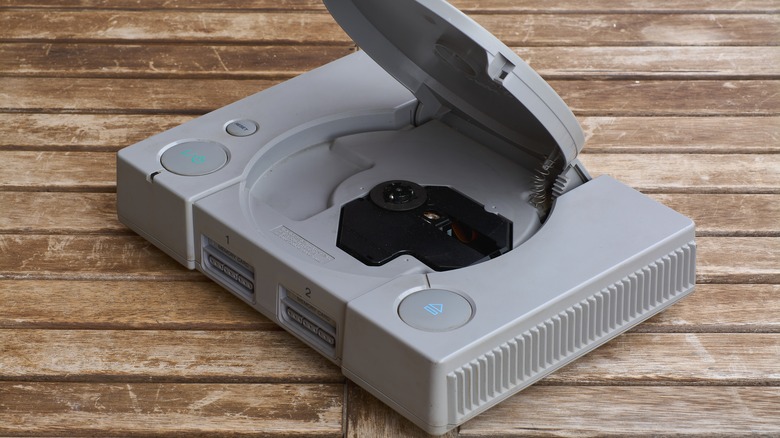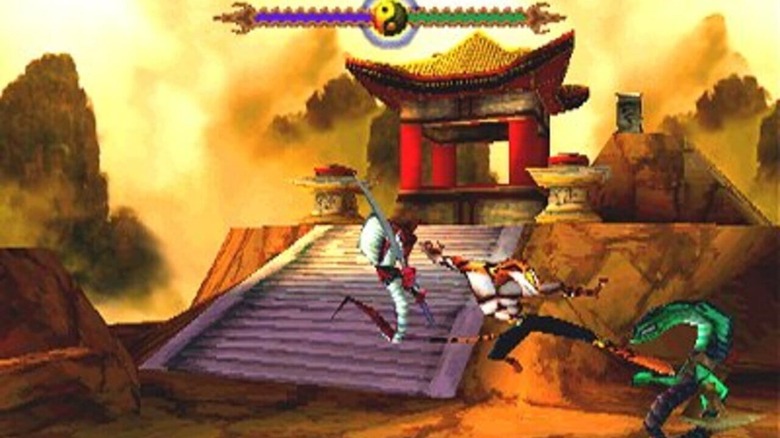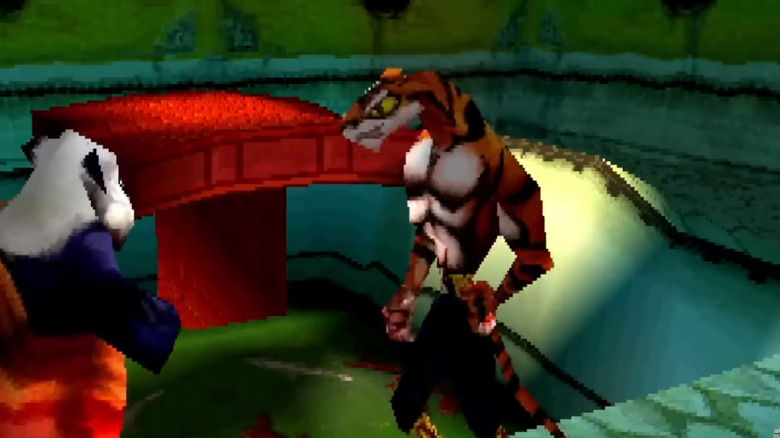The Dreamworks PS1 Game You Probably Never Played
When looking back on the past, people tend only to remember the things that stood out. For example, in the '60s, there were countless new experimental bands, but nowadays, most would be hard-pressed to name any aside from The Beatles or The Beach Boys. Of course, many so-called forgotten bands weren't bad; they just weren't as successful as the "in" thing. Video games are no different. Though some of gaming's most unique titles didn't sell well, they seemed so perfect on paper that it's a wonder they weren't successful. Few games exemplify this idea better than "T'ai Fu."
In theory, "T'ai Fu" should have had everything a late '90s kid could want. It let players take on the role of the titular T'ai Fu, the last living member of the Tiger Clan, in his goal to master Kung Fu and take revenge on the Dragon Master to avenge his people. It's a stylish (if basic) story paired with dozens of combat abilities, an emphasis on combos, and an engaging, platforming-centric world adorned in Chinese and far eastern imagery. The whole package didn't quite come together, though, and "T'ai Fu" received low review scores on launch. As a result, "T'ai Fu" went under most players' radar, but it's worth checking out in 2022 as it's something of a time capsule that represents the style of the PS1 era. Like the "Bloodborne" demake that excited gamers in 2021, "T'ai Fu encapsulates a special time in gaming history — including all the flaws.
T'ai Fu is a love letter to 90's gaming nowadays
"T'ai Fu" put its focus into a few key areas. Platforming is a major element of the gameplay, with levels designed around the use of the 3D space as much as possible. It plays somewhere between a top-down and side-scrolling perspective, giving players better view of hidden areas and their path ahead. The real draw of the game is its combat, which lets players fight other enemies with nothing but T'ai Fu's Kung Fu prowess and a heap of abilities that he learns over the course of the journey. The game's focus on combos sets it apart from other PS1 games, with a lot of variety in how combos can be set up as well as a healing system that encourages players to complete full combos.
At its core, "T'ai Fu" has everything that made gaming in the late '90s so memorable and a few things today's gamers won't understand. Sure, "T'ai Fu" appears incredibly pixelated and jagged now, but the seemingly low resolution was par for the course when it released and the game looks much better in motion on a CRT TV. That said, one of the main problems with the game's visuals is how it appears when not in motion. In many cases, characters and objects are only distinguishable when there's something moving on-screen.
Dreamworks and the development of T'ai Fu
"T'ai Fu" was headed by Lyle Hall, a developer from Crystal Dynamics known for heading "Gex." The game focused on platforming and basic combat like in "Gex," but it was built in the same engine used for the 2D title "The Lost World." As a result, "T'ai Fu" features some remnants of "The Lost World" game design but plays enough with 3D that the overlap is difficult to pick up on. The game's music was composed by industry legend Michael Giacchino. It was also one of "Futurama" alum John DiMaggio's first gaming performances, where he played the role of the titular T'ai Fu.
Dreamworks Interactive was created in 1995 when Dreamworks and Microsoft announced a joint venture, and none other than director Steven Spielberg helped negotiate the studio's funding. Over its five-year existence, Dreamworks Interactive produced 17 games, including franchises like "Medal of Honor" and cult classics like "The Neverhood." Unfortunately, "T'ai Fu" was released close to the end of the company's existence amidst a slew of negatively-received games, like "Trespasser," called "the worst game of 1998" by GameSpot.
Dreamworks Interactive became EA Los Angeles, releasing additional titles in the "Medal of Honor" series and unrelated favorites like "The Lord of the Rings: Battle for Middle Earth." However, after continued tumultuous releases and being rebranded as Danger Close Games, the studio closed in 2013 following the negative reception of 2012's "Medal of Honor: Warfighter."
T'ai Fu had low sales despite its scope and cast
"T'ai Fu" was released in February 1999. This was the same month that one of gaming's most famous party franchises, "Mario Party," began in the U.S. — and it didn't help that it came hot on the heels of the first "Super Smash Bros." game too. Aside from the Nintendo competition, "T'ai Fu" came out one month after "Silent Hill," one of the original PlayStation's most popular titles, and a few months after "Sonic Adventure" hit the Dreamcast. "T'ai Fu" never stood a chance against the competition.
"T'ai Fu" didn't match up to these other titles and fell by the wayside. According to sales aggregate VGChartz, "T'ai Fu" only sold around 150,000 copies over its entire lifetime. For a major studio like Dreamworks, this would have been considered a huge miss, and it's no wonder players never saw a "T'ai Fu" sequel, as Dreamworks allegedly reworked the "T'ai Fu" concept into 2007's "Kung-Fu Panda."
Unlike better-known PS1 games like "Crash Bandicoot," the tale of "T'ai Fu" has been mostly lost to time. Nowadays, interested players can still find copies for around $50 on the web, though a PlayStation console capable of reading PS1 discs is still needed. So if experiencing '90s gaming from the perspective of an oft-forgotten game sounds like a good night, "T'ai Fu" might just scratch that itch.




